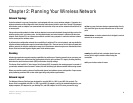
1
Chapter 1: Introduction
Welcome
Wireless-N Access Point with Power Over Ethernet
Chapter 1: Introduction
Welcome
Thank you for choosing the Wireless-N Access Point with Power Over Ethernet. This Access Point will allow you to
network wirelessly better than ever. An access point allows for greater range and mobility within your wireless
network while also allowing you to connect the wireless network to a wired environment. The Wireless-N Access
Point also offers the convenience of Power over Ethernet (PoE) capability (in addition to regular 12VDC power
adaptor), so it can receive data and power over a single Ethernet network cable.
This Access Point supports the latest 802.11n draft Specification by IEEE early 2006. It also support 802.11g and
802.11b clients in a mixed environment. This Access Point currently can support an 11n data rate up to 300
Mbps. Besides the higher data rate, 802.11n technology also promises longer coverage by using multiple
antennas to transmit and receive data streams in different directions. Users are encouraged to update their
firmware through www.linksys.com when 802.11n specification is finalized by IEEE to ensure compatibility with
all the wireless-N devices.
Networks are useful tools for sharing computer resources. You can access one printer from different computers
and access data located on another computer's hard drive. Networks are even used for playing multiplayer video
games. So, networks are not only useful in homes and offices, they can also be fun.
PCs on a wired network create a LAN, or Local Area Network. They are connected with Ethernet cables, which is
why the network is called "wired".
PCs equipped with wireless client cards or adapters can communicate without cumbersome cables. By sharing
the same wireless settings within their transmission radius, they form a wireless network. This is sometimes
called a WLAN, or Wireless Local Area Network. The Access Point bridges wireless networks of 802.11n, 802.11g
and 802.11b standards and wired networks.
Use the instructions in this Guide to help you connect the Access Point, set it up, and configure it to bridge your
different networks. These instructions should be all you need to get the most out of the Access Point.
802.11b: a wireless networking standard that specifies a
maximum data transfer rate of 11Mbps and an operating
frequency of 2.4GHz.
802.11g: a wireless networking standard that specifies a
maximum data transfer rate of 54Mbps, an operating
frequency of 2.4GHz, and backward compatibility with
802.11b devices.
adapter: a device that adds network functionality to your
PC.
ethernet: network protocol defined in IEEE 802.3 standard
that specifies how data is placed on and retrieved from a
common transmission medium.
lan (local area network): the computers and networking
devices that make up your local network.
network: a series of computers or devices connected
together.
poe (power over ethernet): a technology enabling an
Ethernet network cable to deliver both data and power.
access point: a device that allows wireless-equipped
computers and other devices to communicate with each
other and with devices on a wired network. Also used to
expand the range of a wireless network.
802.11n: wireless networking draft standard that specifies
a maximum data rate up to 600Mbps (300Mbps supported
by this device), an operating frequency of 2.4GHz, and
backward compatibility with 802.11b/g devices.


















